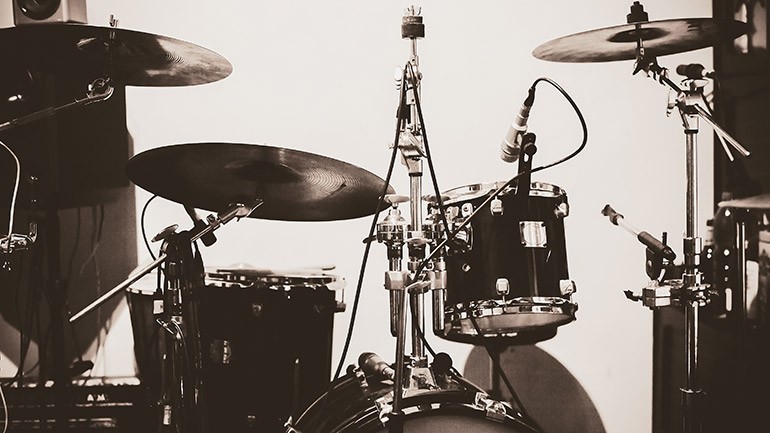Percussion Primer
Another look at the basics of recording percussion, from miking up a full drum kit, to mixing in tambourine, maracas and other accessories

As a practicing producer/engineer, recording percussion— in particular a full-on drum kit— can be among the most challenging duties of all. For starters, one drummer’s approach may be radically different from the next; you could easily find the right sound for a jazz player, then have to start from scratch with a rock basher on the following session. And unlike other studio applications that require only one mic and not much guesswork, engineers frequently use a half-dozen mics or more on a single drum set and must arrange them properly to avoid gremlins like phasing, leakage and other issues.
That said, there are still ways to get a decent backbeat even with a modest mic inventory. Let’s start by looking at some percussion recording basics, from knowing how many mics to use and where to put them, the importance of tuning and dampening, as well as blending in accessories like maracas, shakers, tambourine, cowbell, and more.
Miking a drum kit. Like everything else, the process for recording drums underwent radical changes over the years; whereas one overhead and one bass-drum mic was once good enough, the arrival of big-time multitracking in the 1970s opened the door for a much more granular approach that saw engineers often employing two mics per drum (one each for both top and bottom of snare drum, rack tom and floor tom-tom), along with stereo overhead mics and at least one mic for bass drum.
Which is not to say that you can’t go minimalist if you prefer. In a pinch, I used to place a single Shure SM58 dynamic mic about five feet in front of the kit, aimed just above the bass drum and pointed towards the snare. Add a little touch of compression to hold it all together, and presto—live drums without all the mucky muck.
Ultimately what you want is an arrangement that captures the entire kit with the least amount of equipment possible. The great British engineer Glyn Johns got a fantastic sound using just four mics total—a condenser overhead situated directly above the kit, another one a foot or two above the floor tom-tom, a dynamic mic a few inches from the snare head, and a dynamic bass-drum mic placed close to the outer head (or with the head completely removed) and pointed directly at the beater. The overhead mic picks up most of the kit and provides an ambient feel, while the closer “spot” mics help focus the sound of each drum. Once you’re comfortable multi-miking, you can always augment the setup, such as adding a second overhead, putting a spot mic over the rack tom-toms, or perhaps placing a mic underneath the snare drum to catch some extra snare “rattle.”
Tune up. A good miking strategy won’t matter much without the most important part—an excellent player using a well-tuned kit. To the point that if a drummer compliments me on getting a nice sound, I’ll usually say “hey, you’re getting the sound, I’m just putting a mic in front of it.” And it’s true—someone who instinctively understands feel, rhythm and dynamics makes the job of recording drums so much easier. That person is also more likely to know that tuning is a big part of the equation and will take the time to ensure the snare drum is properly pitched, the toms aren’t overly resonant, and the bass drum is punchy rather than boom-y (removing the outer head and placing some pillows inside the bass drum certainly helps in this regard).
Though most folks prefer to have drums in stereo, always try making a mono mix, even if you’ve used a bunch of tracks—in some instances you may find that the drum sound feels tighter when placed right in the center, and doing so also gives you additional space in the stereo field for other instrumentation.
Percussion aides. Of course, there’s more to percussion than just drums, and to help augment the backbeat you might consider dropping in tambourine, cowbell, shakers, maracas, or similar accessories. When recording, put a little space between the player and the mic (at least a foot or two) so that the sound leans ambient rather than strident. It’s okay to play through the entire track, but when mixing you may find it more effective to only use the parts during certain sections of the song—though it may seem subtle, inserting a tambourine right at the top of a chorus or bridge, for example, often helps highlight the hooks, whether the listener knows it or not. And while you’re at it, always consider adding handclaps here and there, which under the right circumstances can be a remarkable potent ingredient.






Community
Connect with BMI & Professional Songwriters